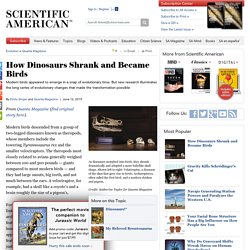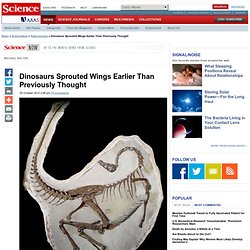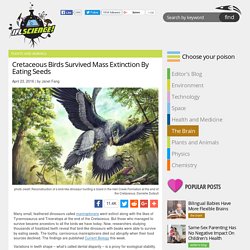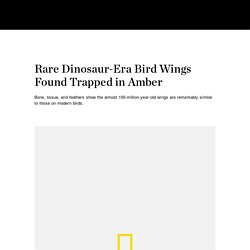

"Dawn" bird oldest found bird. A prehistoric beast the size of a pheasant has become a contender for the title of oldest bird to stalk the Earth.

The small, feathered "Dawn" bird lived around 160m years ago, about 10m years before Archaeopteryx, which holds the official title of the earliest bird known to science. The new species, which scientists have named Aurornis xui, had claws and a long tail, with front and hind legs similar to those of Archaeopteryx, but some features of its bones were more primitive. It measured 50cm from its beak to the tip of its tail. Encased in sedimentary rock, the fossil preserved traces of downy feathers along the animal's tail, neck and chest, but the absence of larger feathers suggests it was not able to fly. When scientists reconstructed the evolutionary tree of similar beasts using measurements from their skeletons, A xui appeared on the bird lineage, but closer to the base of the tree than Archaeopteryx. Archaeopteryx holds a prized position in evolutionary history. How Dinosaurs Shrank and Became Birds.
From Quanta Magazine (find original story here).

Modern birds descended from a group of two-legged dinosaurs known as theropods, whose members include the towering Tyrannosaurus rex and the smaller velociraptors. The theropods most closely related to avians generally weighed between 100 and 500 pounds — giants compared to most modern birds — and they had large snouts, big teeth, and not much between the ears.
A velociraptor, for example, had a skull like a coyote’s and a brain roughly the size of a pigeon’s. For decades, paleontologists’ only fossil link between birds and dinosaurs was archaeopteryx, a hybrid creature with feathered wings but with the teeth and long bony tail of a dinosaur. These animals appeared to have acquired their birdlike features — feathers, wings and flight — in just 10 million years, a mere flash in evolutionary time. To explain this miraculous metamorphosis, scientists evoked a theory often referred to as “hopeful monsters.” When Did Dino's Sprout Wings? Dinosaurs still walk—and fly—among us: We call them birds.

Most paleontologists think birds descended from a group of winged dinosaurs, and thus dinos never went completely extinct. But where did the wings come from? New discoveries from Canada suggest that both wings and feathers arose earlier in dinosaur evolution than previously thought, possibly to attract members of the opposite sex or to protect hatching baby dinos. Although many details of the origins of birds and winged flight are fiercely debated, researchers generally agree that birds belong to a group of dinosaurs called maniraptorans, some of which had feathers and wings and could probably fly.Microraptor, discovered in China, is a leading example of such a dino flyer. Indeed, almost all feathered dinosaurs have been found in the Liaoning and Inner Mongolia regions of northeastern China, where finely grained lake deposits provide excellent preservation of dinosaur fossils; the few exceptions come mostly from Germany.
Dinosaur feather evolution trapped in Canadian amber. Theropod dinosaur evolution into Birds. Dinosaur Skull Collection: Archaeopteryx. Cretaceous Birds Survived Mass Extinction By Eating Seeds. Variations in teeth shape – what’s called dental disparity – is a proxy for ecological stability.

Decreases in variation would indicate ecosystem decline, but if differences between teeth were maintained over time, that would suggest a rich, stable ecosystem. To understand what bird-like dinosaurs were up to at the end-Cretaceous boundary, a team led by Derek Larson from the University of Toronto analyzed 3,104 maniraptoran teeth unearthed throughout western North America. These fossils represent four maniraptoran groups spanning 18 million years of the Cretaceous. Representative teeth from the four groups of bird-like dinosaurs, with enlarged images of tooth serrations. Scale = 1 mm. Tooth shape disparity showed no major decline leading up to the mass extinction event within any of the groups studied, but this prolonged period of ecological stability was followed by the sudden extinction of many bird-like dinosaurs.
Photo Gallery. Rare Dinosaur-Era Bird Wings Found Trapped in Amber. Two tiny wings entombed in amber reveal that plumage (the layering, patterning, coloring, and arrangement of feathers) seen in birds today already existed in at least some of their predecessors nearly a hundred million years ago.

A study of the mummified wings, published in the June 28 issue of Nature Communications and funded in part by the National Geographic Society's Expeditions Council, indicated they most likely belonged to enantiornithes , a group of avian dinosaurs that became extinct at the end of the Cretaceous period. (Read more about the evolution from dinosaurs to modern birds.) 'Mind-Blowingly Cool' While the fact that many, if not nearly all, dinosaurs were feathered has been generally accepted since the 1990s, our knowledge of prehistoric plumage until now has come from feather imprints in carbonized compression fossils and individual feathers fossilized in amber.
(See dinosaurs in their feathered glory.) Familiar Feathers A Bountiful Fossil Source in a Troubled Area. Bird Beaks.